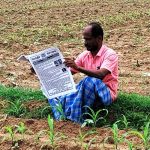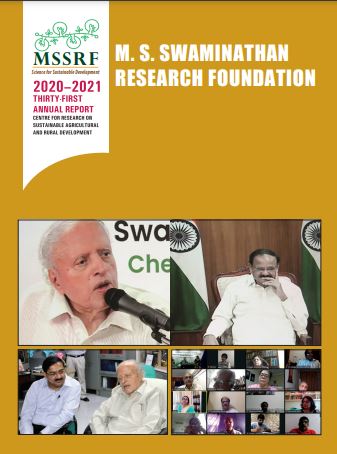Understanding gendered differences among smallholders while accessing agricultural advisories
The small farmers are in constant need of information and advisory services on agricultural inputs, plant health, financial services, market and weather updates, farm machinery, water sources, crop insurance, livestock management, entitlement schemes, and so on. The multiple challenges of public extension systems, including inadequate human resources (low ratio of agricultural extension workers to farmers), limit farmers’ access to locale-specific and farmer-centric agricultural extension services. This is prominent for small farmers in India, who make-up almost 85 per cent of the total farmers[i].
MSSRF conducted a study to understand the types of information required, sources currently accessed, and barriers that hinder access to reliable sources. The study covered 50 farmers (31 men and 19 women) in the Aranthangi and Thiruvarankulam blocks of Pudukkottai district, Tamil Nadu. Currently, they receive the required advisories from multiple sources including line departments, Krishi Vigyan Kendras (KVKs), State Agriculture Universities (SAUs), input dealers, Farmer Producer Organisations (FPOs), mass media, Non-Governmental Organisations (NGOs), and others.
The study reveals that farmers need two different categories of information, and currently, they receive/access it from distinct sources. In the first category, a public extension system is effective in delivering the schemes and programmes that are largely linked with subsidy-based inputs and infrastructure (seeds/manures and fertilizers, micro-nutrients/farm machinery/irrigation systems), etc. Women farmers appear to have a better understanding of the schemes and machinery availability compared to men farmers. As Self-Help Groups (SHGs) or farmer interest group members, these women participate regularly in training or meetings organised by the Government departments, and this exposure has contributed to increased awareness about information from government departments [ii]. 84 per cent of the information received from government departments on schemes and accessing subsidies are practised by the farmers. According to them, since the department advisories are on schemes and programmes, they immediately approach the concerned officials to avail them.

For the technical and dynamic farmer-centric advisories, farmers depend on private sources, primarily from non-governmental development organisations followed by local agro-input dealers. Such advisories cover a wide range of topics such as pest and nutrient management, seed treatment, varietal selection, land preparation and tillage, soil health and weed management, market pricing, and animal husbandry/livestock management. Out of 50 farmers, 70 per cent understood the advisories, while the remaining farmers were unable to understand despite receiving it. In particular, two out of five female farmers (42 per cent) could not comprehend the advisories, compared to 23 per cent of men farmers (one out of five). This indicates that farmers, especially women farmers, need support to build their skills to translate the advisories into action. Between the sources, the adoption rate was higher for the advisories received from non-governmental sources. Both men and women farmers expressed that advisories were clear and timely, and they get back to the sources for more details and clarification if needed. While in the case of input dealers – farmers generally depend on them to access details and inputs on seeds and pest management. However, 64 per cent of men depend on input dealers for seeds, and it was 30 per cent among women. In the case of pest management information, 50 per cent of women depend on input dealers and only 27 per cent of men depend on them.
To conclude, farmers depend on private sources for the dynamic agro-advisories, and there is a gendered gap in translating the advisories into action. In the context of the increasing role of women farmers in the production phase, there is a need to build the skills of women to use the advisories effectively through structured capacity-building programmes.
[i] https://www.fao.org/india/fao-in-india/india-at-a-glance/en/
[ii] https://www.sciencedirect.com/science/article/pii/S0305750X2100190X

